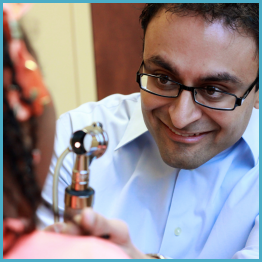On this page we cover:
- Frenectomy
- Lingual Frenectomy
- Excision Mucocele
- Surgery for Drooling
Frenectomy
ENT for Children may recommend a frenectomy (release of the frenulum), a frenulectomy (excision of the frenulum) or frenuloplasty (excision of the frenulum with closure), for children who suffer from ankyloglossia (tongue tie). The procedure involves the removal of the frenum, which is the muscular attachment between the two tissues that prevents the tongue from moving.
Lingual Frenectomy/Frenulectomy/Frenuloplasty

If your child is a newborn, the procedure is done awake in the office. A small incision is made through the frenulum, which will free the tongue from the floor of the mouth. Your child should be able to nurse immediately afterwards.
For older children, this procedure is done in the operating room under general anesthesia. The frenum is typically injected with a local anesthetic, and is released using sharp instruments. The resulting defect is closed using absorbable sutures. This is done as an outpatient procedure, and recovery is usually between 1-3 days, depending on the age of the child. Breast-feeding afterwards in older children may be difficult for the first 48-72 hours and bottle supplementation may be needed.
Excision Mucocele
ENT for Children may recommend excision of a mucocele from your child’s mouth. Mucoceles may occur on your child’s lower lip but may also appear on the soft palate, floor of the mouth, cheek and tongue. Most mucoceles disappear after 3 to 6 weeks. Your pediatric ENT specialist might recommend surgical removal if your child’s condition lasts for more than two months or if the lesion bleeds increases in size or makes it difficult for your child to talk or chew.
We remove mucoceles under a general anesthetic in the operating room as a day surgery procedure. The surgery requires removal of the cyst with its overlying tissue, and the underlying minor salivary gland. Absorbable sutures are placed to close the wound. Recovery averages 1-3 days with some mild swelling to the area where the mucocele was excised.
Surgery for Drooling

Saliva is important in oral hygiene and for aiding food digestion. The three major salivary glands are the parotid, submandibular and sublingual glands. While infants normally produce excessive saliva, corrective action may be necessary for a child that has excessive salivation (drooling) as they become older. Many children are initially evaluated by speech/swallowing therapist and receive benefit, but some children (particularly who have neuromuscular disorders) continue to have excessive drooling. Excessive drooling can result in skin breakdown around the mouth, localized skin infections, and social embarrassment.
The ultimate goal in children with excessive drooling is to reduce the saliva production but not eliminating the saliva production. There are procedures that exist to reduce the saliva production, including the following:
Bilateral submandibular duct/Parotid duct ligation: this procedure involves ligating (tying off) of the ducts that drain from the glands. Typically, both submandibular ducts and one parotid gland is ligated, either by suture or by clips. One parotid duct is left open for salivary production, but may need to be ligated at some point if excessive salivation continues. The procedure is done under a general anesthetic and can be an outpatient procedure. There may be temporary swelling to the ligated glands, but that usually resolves over time.
Bilateral Submandibular Duct Transposition(BSMDT): a BSMDT (Bilateral Submandibular Duct Transposition) is a surgical technique that involves moving the submandibular ducts underneath your child’s tongue to the back of the mouth. The treatment will allow your child to swallow saliva rather than coming out the front of his mouth. This procedure is only for children who do not have problems with aspiration of food or liquids.
The surgery is performed under general anesthesia. During the procedure the submandibular ducts are moved from their original position through an incision and rerouted towards the back of your child’s mouth and sutured into place. The incision is closed by using dissolvable stitches. Your child may have some difficulty swallowing immediately after surgery do to soreness, and may require an overnight stay in the hospital.
Submandibular duct excision: this procedure involves removal of both submandibular glands. It may also involve ligation of one of the parotid ducts. This requires a general anesthetic. The procedure is done through an external neck incision near the submandibular gland below the jaw. The gland and its duct is removed completely on both sides. A drain is placed within the wounds and removed within 1-2 days. This procedure may require an overnight stay. Risks involved with this procedure include injury to the lingual nerve (nerve involved in tongue sensation) and marginal mandibular nerve (nerve involved with facial movement around the mouth).
